“If—” a poem by Rudyard Kipling, 1865 – 1936
If you can keep your head when all about you
Are losing theirs and blaming it on you;
If you can trust yourself when all men doubt you,
But make allowance for their doubting too;
If you can wait and not be tired by waiting,
Or, being lied about, don’t deal in lies,
Or, being hated, don’t give way to hating,
And yet don’t look too good, nor talk too wise;
If you can dream—and not make dreams your master;
If you can think—and not make thoughts your aim;
If you can meet with triumph and disaster
And treat those two impostors just the same;
If you can bear to hear the truth you’ve spoken
Twisted by knaves to make a trap for fools,
Or watch the things you gave your life to broken,
And stoop and build ’em up with wornout tools;
If you can make one heap of all your winnings
And risk it on one turn of pitch-and-toss,
And lose, and start again at your beginnings
And never breathe a word about your loss;
If you can force your heart and nerve and sinew
To serve your turn long after they are gone
And so hold on when there is nothing in you
Except the Will which says to them: “Hold on”;
If you can talk with crowds and keep your virtue,
Or walk with kings—nor lose the common touch;
If neither foes nor loving friends can hurt you;
If all men count with you, but none too much
If you can fill the unforgiving minute
With sixty seconds’ worth of distance run—
Yours is the Earth and everything that’s in it,
And—which is more—you’ll be a Man, my son!
What can I say? Kipling had a way with words. By the way, his first name was Joseph. Rudyard was actually his middle name. Please note that the poem is in the public domain.
In the Last Blog Post
In the last blog post, Teacher & Student Burrowing Owl Successes at Cape Coral, here, thanks to the very few folks who left a comment. I loved #4, the alarmed baby owl for the posture and the wide-eyed look. #2, “The Lineup” was very special as well. As was Pat’s image. Perhaps my very favorite was #5, Burrowing Owl large chick stretching one wing; I love the wing stretch, the composition-balancing stalk in the upper right, and the overall softness of the image. Everyone I’ve shared the image had a very positive reaction to this photo. Thus, I was quite surprised that one commenter went out of her way to state this about Image #5: … doesn’t do a lot for me.
I guess that there is no accounting for taste.
What’s Up?
We had a fabulous Monday morning with Pat Fishburne at Cape Coral. I was headed home, exhausted, to ILE before 11:00am. Tuesday morning at ILE was quite excellent as well. We saw seven of the nine young cranes and photographed six of them. We also got to photograph two Cattle Egrets standing in the water along the shore of Lake Walk-in-Water (AKA Lake Weohyakapka) along with a very handsome juvenile Crested Caracara.
The a-1 ii pipeline is opening up a bit. I was glad to learn yesterday that Rupert (Charlie) Curry and Geri Georg got their a-1 ii bodies from Bedfords. The previous week Larry Master and Robin Roberts got theirs from B&H. I spent lots of time updating my a-1 ii bodies to Firmware 2.01 and my remaining a-1 body to Firmware 3.01. I also got a bit more work done on the BAA 400-800mm Lens Guide (free to all who use one of my two affiliate links to purchase their 4-8; otherwise, $101.43 via PayPal to e-mail.) Right now, it is very difficult to get your hands on either a 400-800 or an a-1 ii. Be sure to use one of my two affiliate links to earn your free lens or camera guide. The latter includes my settings in the form of a .DAT file, instructions on getting that onto your camera, a Button and Dials Guide, and a detailed INFO sheet.
This rather short blog post took more than two hours to create including the time spent on the image optimizations.
Today is Wednesday 23 April 2025. We will be headed down to the lake in the dark to practice shooting the baby cranes at ISO 25600. No kidding. Then, I will be working on the Buttons and Dials Guides and the INFO Sheets for both the a-1 and a-1 ii Firmware updates. Whatever you opt to do, I hope that you too choose to have a wonderful and productive day. Do remember that happiness is a choice — Byron Katie, The Work.Com.
If an item — a Delkin flash card, or a tripod head — for example, that is available from B&H and/or Bedfords, is also available in the BAA Online Store, it would be great, and greatly appreciated, if you would opt to purchase from us. We will match any price. Please remember also to use my B&H affiliate links or to earn 3% cash back at Bedfords by using the BIRDSASART discount code at checkout for your major gear purchases. Doing either often earns you free guides and/or discounts. And always earns my great appreciation.
Don’t Just Shoot: Learn
If you are interested in changing your life and becoming a better photographer by joining me on an Extended IPT at Sebastian Inlet for Ospreys and more (SEPT 25 to NOV 24, 2025) or in San Diego for Pacific-race Brown Pelicans and more (JAN 6 to FEB 2, 2026), please e-mail for dates, rates, terms, and additional information. Or shoot me a text to 863-221-2372. Both offerings include options for shared AirBnB lodging and ground transportation during your stay.
Indian Lake Estates BAA Baby Crane In-the-Field Sessions
I am currently available for morning BAA Baby Crane In-the-Field sessions on the following dates: April 24, 29-30, and at least the first half of May. Please e-mail for costs and additional information. Or, shoot me a text to 863-221-2372.
|
|
|
These two image were created on 22 April down by the lake near my home at Indian Lake Estates, FL. Standing on the slope leading down to the South Canal, I used the hand held Sony FE 300mm f/2.8 GM OSS Lens (Sony E) and The Latest Greatest Sony Flagship Body, the a1 II Mirrorless Camera. ISO 320. Exposure determined via Zebras with ISO on the Thumb Wheel; 1/2500 sec. at f/2.8 (wide open) in Manual mode. RawDigger showed that the exposure was dead solid perfect: AWB at 8:11:22am on a variably sunny morning. Wide/AF-C with Bird Eye/Face Detection enabled performed perfectly. Image #1: A Two-frame Composite |
Wide Autofocus Tip For All (especially Mirrorless) Systems
I am pretty sure that all high-end mirrorless and most of the more recent dSLR camera bodies offer some sort of broad or wide AF patterns that cover nearly all of the frame. In addition, most of the bodies mentioned previously have some smaller zone AF coverage choices. In the situation that I was faced with above — on bird on my right and two on my left, the trick to get the camera to focus where you want it to is to place the subject in the center of the frame and then recompose.
I was using Wide AF-C with Bird Face-Eye enabled. As the single bird on my right was slightly closer to me than the adult and the large chick on my left, I first centered the single large chick on my right in the center of the frame (and thus in the center of the AF coverage), half-pressed the shutter button to acquire focus, and then moved the lens to the left so as to include the feeding in the frame. That of course is the image on our left above.
Then I had a brilliant thought — focus on the feeding and create an image that could be focus stacked with the first image. So I followed the same procedure as above: I first centered the feeding on my left in the center of the frame (and thus in the center of the AF coverage), half-pressed the shutter button to acquire focus, and then moved the lens to the right so as to include the single young bird in the frame. That of course is the image on our right above.
|
|
|
This image was created from the two images above — a sort of crude, two-frame focusing stacking. Be sure to click on the image to view the larger, inexplicably sharper high-res version. Image #2: Sandhill Crane adult feeding one of its two chicks |
The Image Optimization
I converted both images using the same settings (via Apply Previous Settings, of course). Then I painted a Quick Mask of the single bird, the sky, and the foreground grass in _DSC2519 and moved it roughly into place atop _DSC2522. After fine tuning the placement, I added a Regular Layer Mask and brushed away some of the upper layer to minimize the depth of field mismatch in the foreground grass. After flattening the top two layers, I ran a 65-pixel Gaussian Blur on a new layer, hid that with an Inverse (Hide-all, or Black) Mask, and incrementally painted in some blur on the grasses in front of the sharp bird. I was more than happy with the result.
Note that I added a bit of out of focus greenery to the left of the feeding to balance the image design. I used the Remove Tool to eliminate a very few sharp blades of grass. The whole image optimization process will be part the Digital Basics IV Video Series that will hopefully be available at the end of May. 2025.
Compare the two originals and note that because I was hand holding, the framing of the two images was different.
|
|
|
h2>Image #3: A 100% crop of the Sandhill Crane adult feeding one of its two chicks image |
You Gotta Be Kidding Me
This tight, 100% crop of the feeding shows the incredible detail that comes with every sharp Sony a-1 ii raw (ARW) file.
Should You Upgrade to or Purchase a Sony a-1 ii?
I received my second a-1 ii two weeks ago. I continue to be amazed by speed and accuracy of the Bird Face-Eye tracking in AF-C and the overall performance of the camera.
Aside from the improved ergonomics as compared to the a-1, other nice features include the fact that the rear screen tilts both ways. Pre-capture has proven to be a huge plus; in my opinion, the Speed Boost feature is a total waste for bird photography. In addition, the resolution on the rear monitor has been improved dramatically (not that I would notice). Bird Face-Eye tracking on the a-1 ii is vastly improved as compared to both the a-1 and the a9 iii and the 51MP files are to die for.
So, the big question is, is the a-1 ii “worth” a gear upgrade. Remember that I can never know whether or not something is worth it to for someone else. I can say that I was not floored when first using my a-1 ii. The differences between the a-1 ii and the original a-1, seemed to be neither huge nor eye-opening. But over time, I came to realize that I was 100% wrong.
The huge difference between the new camera body and the older a9 iii is, of course, the 51MP a-1 raw files (as compared to the 24MP files rendered by the a9 iii). That said, Pat’s image above stood up quite well to a rather substantial crop from below and from our left.
With the price of a brand new a-1 having recently dropped $1500.00 to $4,998.00, the decision for new Sony buyers is a tough one. The a-1 ii sells new for $6,498.00. And the price of used a-1 bodies will continue to drop (but surely not as much as I had thought before using the a-1 ii). But for me, the a-1 ii is clearly far superior to the original a-1 for bird photography.
If you do purchase an a-1 ii, be sure to use one of my two affiliate links so that you will receive my a-1 ii settings (in the form of a CAMSEa1ii.DAT file), the Buttons and Dials Guide, and an Info Sheet. Folks who do not purchase their new a-i ii using my B&H link or from Bedfords here and entering the BIRDSASART discount code at checkout will be able to purchase the a-1 ii guide for $227.43. If you are at all confused and do not want to screw up your order, please get in touch via e-mail.
Typos
With all blog posts, feel free to e-mail or to leave a comment regarding any typos or errors.

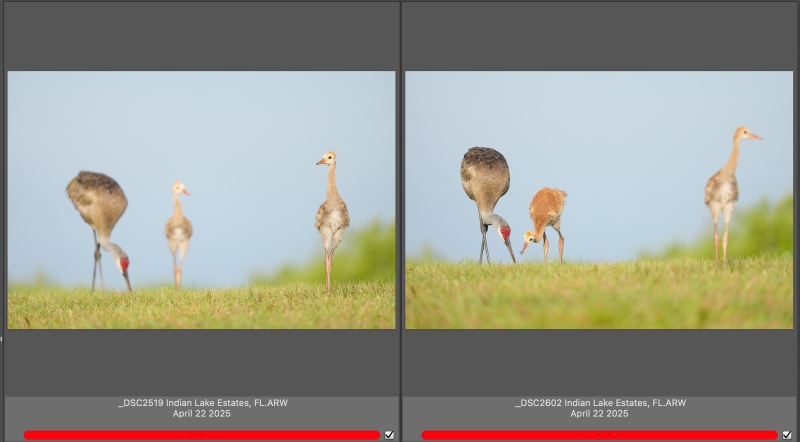
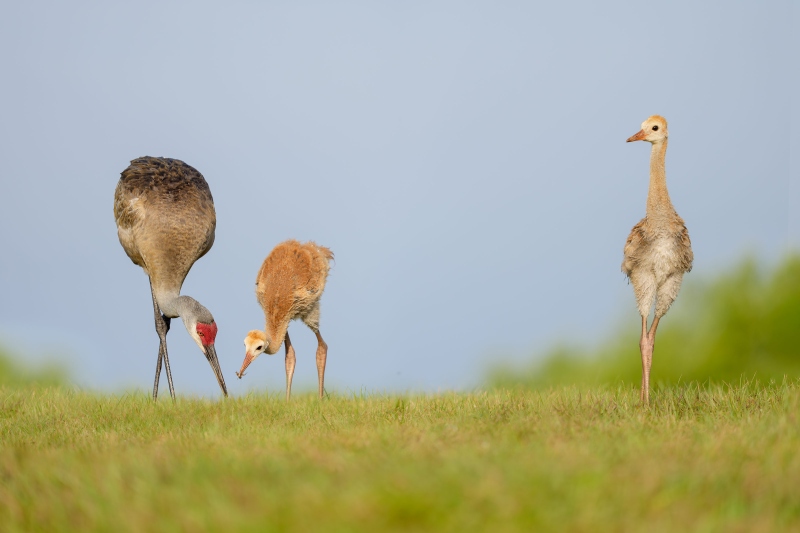
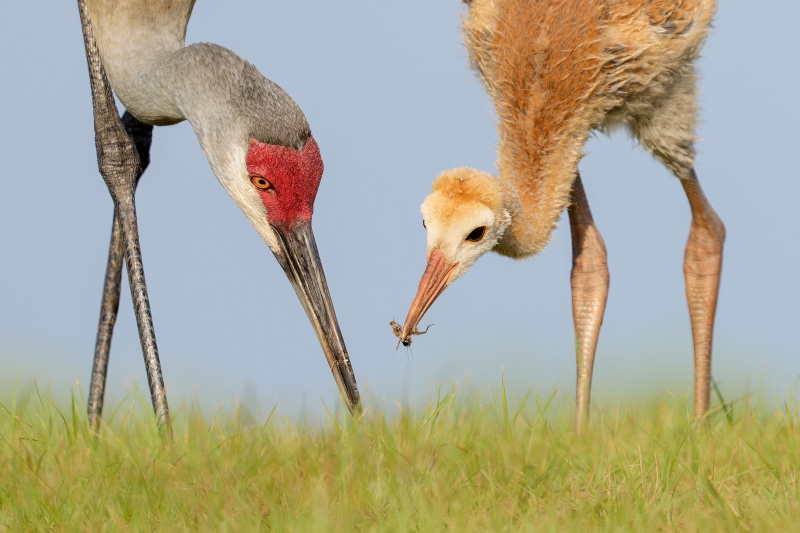






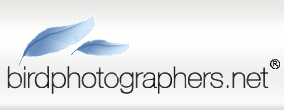


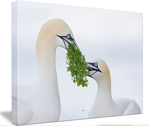



Beautiful poem (surely one of the truest ever written) and beautiful captures and processing on the crane family. What jumped out at me was the gap between the two merged frames–2519 to 2602! (I’m normally merging within a frame or three.) The high frame rate accounts of much of that, I’m sure, but from your description, maybe also the slightly delayed realization that a merge would work. Good thinking!